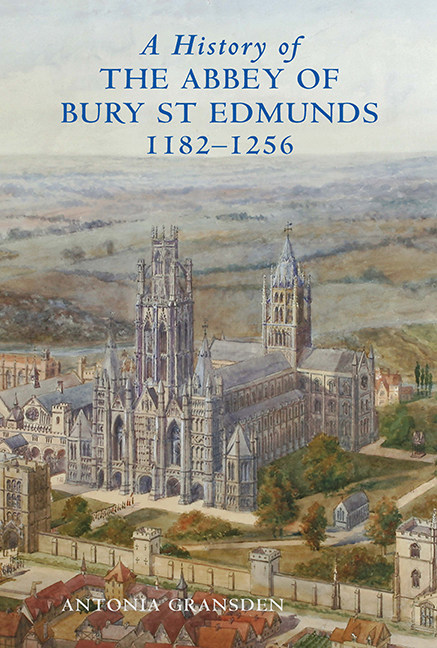Book contents
- Frontmatter
- Dedication
- Contents
- List of plates
- List of figures
- Preface
- Editorial Note
- Epigraph
- Acknowledgements
- Maps and plans (figures 1–9)
- Part I Samson of Tottington, Abbot 1182–1211
- 1 Samson's biographer, Jocelin of Brackland (de Brakelond), and his work
- 2 Samson's early life and career
- 3 Samson's election to the abbacy
- 4 The early years of Samson's abbacy and reform of estate management
- 5 Conflict with the convent
- 6 Relations with the town of Bury St Edmunds
- 7 Samson and secular law
- 8 Samson and the knights of St Edmund
- 9 Relations with the Angevin kings
- 10 Samson and the papacy
- 11 Samson as a builder
- 12 Religious and intellectual life under Samson
- 13 Samson's death and burial
- PART II The Abbey 1212–1256
- APPENDICES
12 - Religious and intellectual life under Samson
from Part I - Samson of Tottington, Abbot 1182–1211
Published online by Cambridge University Press: 29 April 2017
- Frontmatter
- Dedication
- Contents
- List of plates
- List of figures
- Preface
- Editorial Note
- Epigraph
- Acknowledgements
- Maps and plans (figures 1–9)
- Part I Samson of Tottington, Abbot 1182–1211
- 1 Samson's biographer, Jocelin of Brackland (de Brakelond), and his work
- 2 Samson's early life and career
- 3 Samson's election to the abbacy
- 4 The early years of Samson's abbacy and reform of estate management
- 5 Conflict with the convent
- 6 Relations with the town of Bury St Edmunds
- 7 Samson and secular law
- 8 Samson and the knights of St Edmund
- 9 Relations with the Angevin kings
- 10 Samson and the papacy
- 11 Samson as a builder
- 12 Religious and intellectual life under Samson
- 13 Samson's death and burial
- PART II The Abbey 1212–1256
- APPENDICES
Summary
The shrine and cult of St Edmund
The shrine of St Edmund, the centre of the martyr's cult and the magnet which drew the pilgrims, was very splendid. It lay behind the high altar and, like all great shrines, consisted of two main parts, the feretory containing the saint's coffin and a base. The feretory was of the normal kind, a rectangular wooden box, a little larger than the coffin, with a gable roof like that of a house. It was covered with silver plates and Samson gave a golden crest to surmount the gable ridge, and Robert of Graveley gave a canopy, with pictures painted on it, to fit over the feretory. The canopy would have been made of wood and usually hung above the feretory, suspended by ropes, but sometimes it would have been lowered to cover the feretory. This was possible because the ropes were attached to pulleys fixed either to the underside of the vault or to beams above it; in the latter case the ropes would have passed through holes in the vault. The actual form of the feretory would not have altered in the course of the middle ages, though the accumulation of precious votive offerings, which were attached to it every now and then, would have altered its superficial appearance. Its general appearance in the late middle ages can be seen from the five miniatures of the shrine illustrating John Lydgate's Lives of St Edmund and St Fremund in BL MS Harley 2278 (ff. 4v, 9, 100v, 108v, 109). Henry VIII's commissioners in 1538 described it as ‘a rich shrine which was very cumbrous to deface’.
On the other hand, the base of the shrine in Samson's time was the one constructed for Abbot Baldwin's Romanesque church and it was unlike the base depicted in the Lydgate manuscript. Although each of the five miniatures in the manuscript depicts the shrine slightly differently, they all agree about the type of the base – it belonged to a type fashionable in the later middle ages. It was a solid masonry base with nitches in its sides.
- Type
- Chapter
- Information
- A History of the Abbey of Bury St Edmunds, 1182–1256Samson of Tottington to Edmund of Walpole, pp. 94 - 144Publisher: Boydell & BrewerPrint publication year: 2007



